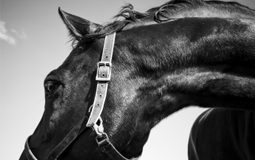
Endurance riders and racehorse trainers frequently used heart rate monitors for their horses, and this tool can be useful for equestrians in other sports as well.
When it comes to improving horses’ strength and fitness, our most common markers of progress include a fair amount of guesswork, not reliable statistics. To avoid training plateaus, injury, and boredom I recommend that students employ a sharper focus to vary their daily routines and track changes. In particular, a heart rate monitor can give the rider indisputable useful information about her horse.
A heart rate monitor eliminates the rider’s impulse to make assumptions about how hard her horse is—or is not—working. Sometimes, we riders will think we’ve worked the horse quite hard, when it turns out that is not at all the case. Other times, we might fail to hold him at the right effort for sufficient time to make gains. Or we might miss feedback day to day that informs us about the horse’s fatigue or stress, or an injury starting. Without a heart rate monitor, riders default to drawing conclusions by how the horse “feels,” or from his respiration rate. Neither of these offers the same accuracy of as heart rate.
Heart rate monitors have long been used for disciplines like endurance and racing, but arena riders are increasingly putting them to use. High profile riders like Grand Prix dressage trainer Adelinde Cornelissen have promoted their value for less intense disciplines. Even in a sport like dressage that favors strength building over extreme cardiovascular output, heart rate monitors provide information that keeps training on track.
Working Hard or Hardly Working?
A heart rate monitor can tell you if you are working your horse too hard, or maybe not hard enough. It informs you how he recovers from each training session, which gives an indication of the workout’s overall effect. Heart rate monitors can show when your horse has adapted to a level of exercise and is ready for the next.
For example, my young Warmblood mare used to show a heart rate around 116 beats per minute (bpm) for her normal working trot. As she matured and focused, and her movement became more efficient through training, I noted last week that her heart rate during working trot rarely got above 90bpm. That tells me that I can begin challenging her with harder work and exercises; she is prepared and ready. Moving forward from here, if I were to continue working her at the same intensity level as I have for the past 6 months, I would not achieve any gains in her development. The workload would simply be too light and not stimulate any physiological adaptations. And without creating further metabolic and strength adaptations, I would only be putting ‘wear and tear’ on her body through repetitive motions.

Using a horse heart rate monitor.
A Clue to Behavioral Problems
I have occasionally used a heart rate monitor to solve the question of whether a horse finds an exercise too difficult or is acting out for different reasons. An example: an Arabian gelding came to me with an uncoordinated but willing right lead canter, but his left lead involved bucking and head-tossing and agitation. His owner thought he was just acting like a brat. Out of curiosity, I put the heart rate monitor on and asked him to canter in each direction. Going right, the monitor read 110bpm. Taking the left lead, though, it jumped to 120bpm and kept climbing the longer we stayed in it. It leveled off near 135bpm, a huge difference from the opposite direction! That told me without a doubt that he was not being a brat; the left canter was either very difficult or very painful for him. Obviously, we needed to figure out which it was. With the information from the heart rate monitor, we could approach the left lead issue with much greater focus.
Obviously, arena riders do not need to use a heart rate monitor every day. Vital information can be added to a training program by using it just once or twice a week. Affordable and easy to use, they quickly become one of a rider’s most trusted feedback sources. As an average guideline for starting out, your horse’s resting heart rate will be 28-40bpm; walk is between 60-80bpm; trot is between 80-110bpm; canter range is 90-130bpm. Now, get out there and enjoy your horse’s heart.
Author, speaker, and trainer Jec
Aristotle Ballou teaches widely as a horse fitness specialist. A
frequent presenter at national expos, she helps riders of all
disciplines cross-train with dressage. Her books are sold widely both
nationally and internationally. Visit her website at www.JecBallou.com.





